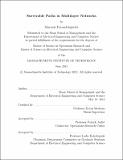Survivable paths in multilayer networks
Author(s)
Parandehgheibi, Marzieh
DownloadFull printable version (3.864Mb)
Other Contributors
Massachusetts Institute of Technology. Dept. of Electrical Engineering and Computer Science.
Advisor
Eytan Modiano.
Terms of use
Metadata
Show full item recordAbstract
We consider the problem of protection in multilayer networks. In single-layer net- works, a pair of disjoint paths can be used to provide protection for a source-destination pair. However, this approach cannot be directly applied to layered networks where disjoint paths may not always exist. In this thesis, we take a new approach which is based on finding a set of paths that may not be disjoint but together will survive any single physical link failure. First, we consider the problem of finding the minimum number of survivable paths. In particular, we focus on two versions of this problem: one where the length of a path is restricted, and the other where the number of paths sharing a fiber is restricted. We prove that in general, finding the minimum survivable path set is NP-hard, whereas both of the restricted versions of the problem can be solved in polynomial time. We formulate the problem as Integer Linear Programs (ILPs), and use these formulations to develop heuristics and approximation algorithms. Next, we consider the problem of finding a set of survivable paths that uses the minimum number of fibers. We show that this problem is NP-hard in general, and develop heuristics and approximation algorithms with provable approximation bounds. We also model the dependency of communication networks on the power grid as a layered network, and investigate the survivability of communication networks in this layered setting. Finally, we present simulation results comparing the different algorithms.
Description
Thesis (S.M.)--Massachusetts Institute of Technology, Sloan School of Management, Operations Research Center; and, (S.M.)--Massachusetts Institute of Technology, Dept. of Electrical Engineering and Computer Science, 2012. This electronic version was submitted by the student author. The certified thesis is available in the Institute Archives and Special Collections. Cataloged from student-submitted PDF version of thesis. Includes bibliographical references (p. 75-77).
Date issued
2012Department
Massachusetts Institute of Technology. Department of Electrical Engineering and Computer Science; Massachusetts Institute of Technology. Operations Research Center; Sloan School of ManagementPublisher
Massachusetts Institute of Technology
Keywords
Operations Research Center., Electrical Engineering and Computer Science.